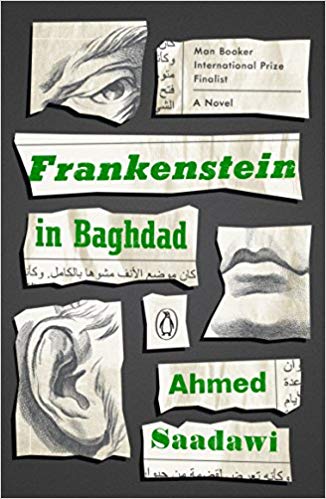In Ahmed Saadawi’s Frankenstein in Baghdad, it takes a neighborhood of strange characters, rather than an over-reaching scientist as with Mary Shelley’s Frankenstein, to create a monster. And it takes a good story, whether or not it is true, just so long as it is believed.

There are many stories and levels of truth in this remarkable novel, beautifully translated by Jonathan Wright. Frankenstein in Baghdad is a portrait of a shattered society, full of people trying to capture something missing from their lives. They all tell stories that help make sense of fantastic events in a war-torn city.
Baghdad under American occupation following the 2003 invasion seems made up of disjointed parts, much like the body of the monster that has taken to killing people, apparently at random. In the midst of car bombs that kill indiscriminately, American and government troops rounding up and torturing suspects, Sunni and Shiite militias fighting to control different sections of the city, terrorists carrying out their deadly mission, even stranger events start happening on Lane 7 in the Bataween district.
Stories of a Monster and Truth
Hadi, a junk collector and dealer, well-known for his drunken story-telling, hates to see the mangled bodies of car bomb victims treated like trash, their limbs all mixed in piles. This hits him especially hard after his friend and business partner of many years is torn apart by an explosion. At the morgue, an attendant encourages him to assemble a body from the jumbled limbs.
Hadi can’t stand this disrespect for the dead and starts collecting body parts from the scenes of explosions and secretly stitches them together. He has no idea what he will do with the assembled corpse, but one night the body disappears.
It turns out that the spirit of a dead security guard, whose own body was obliterated by a bomb, has been looking for an intact corpse to slip into so that he can be buried and find peace. He finds the body in Hadi’s house and so the stitched up body, that Hadi refers to as Whatsitsname, comes to life and slips away.
His first destination is the house next door where the elderly Elishva, an Assyrian Christian, has been patiently waiting for the return of her son Daniel. She refuses to believe that he died in the war twenty years before. With her poor eyesight, she readily believes that the person who has wandered into her house is her son. She clothes and feeds him and starts telling everyone in the neighborhood that her long lost son has finally come home.
The First True Iraqi Citizen
So now, with a body, a spirit and a name, the creature feels he needs a purpose. That is provided by the dozens of people whose body parts compose him. They cry out for vengeance, and Whatsitsname sets off to murder those responsible for all these deaths.
But deciding who is responsible isn’t easy. Eventually, Whatsitsname comes to believe that everyone in this city is part innocent and part criminal, as he himself is. He is a monster who kills but with a conscience and a sense of justice. Stories about him spread far and wide. He attracts followers who believe he is godlike, worship him and then fall to fighting among themselves.
Whatsitsname comes to see himself, made up of so many contradictory and incompatible parts, like his country, as the first true Iraqi citizen.
Many Narratives, Many Truths
Appropriately enough, the story unfolds through multiple perspectives and stories, all of which are thrown in doubt by various witnesses. The narrative structure of Frankenstein in Baghdad is as fragmentary as the monster but is vibrant throughout with the lives of bizarre characters.
The author uses the indirect free style, which mixes elements of first and third person voices. As a result, it is sometimes hard to distinguish between a character’s story-telling and the immediate context in which the story is being told.
When Hadi is regaling his friends about Whatsitsname, for example, I often had to stop to check whether I was following a past incident in the story or something that was happening in Hadi’s present. That isn’t as confusing as it sounds. Rather the style contributes to the effect of testing boundaries between reality based on fact and reality based on what people want or need to believe.
Whatsitsname becomes a legend. Mahmoud, the journalist, wants to print a story about him, which finally appears with the sensational title, Frankenstein in Baghdad, but he denies to the authorities that it is anything more than a fantastic tale made up by a neighborhood drunk.
Unreliable Characters
Mahmoud confesses to Hadi that his family origins are not Arabic at all. He came to Baghdad on the run from a local leader in his home town who was out to get him. He is at loose ends, hoping to imitate the success of his employer, who has a big network of contacts and a foreign lover whom Mahmoud hopes to seduce. He hopes that the Whatsitsname story will boost his reputation and make him famous.
He patterns himself after his boss, Saidi, who has cultivated so many myths and stories about himself that Mahmoud can’t be sure of anything about him. Nevertheless he admires him and starts to look and sound like him. His role model turns out to be a crook who flees the country with millions of stolen dollars. Or is that just another rumor, one that Saidi himself denies?
The closer you look at each character, the less you really know about them. It’s hard to separate fact from fiction since people keep telling or encouraging stories about themselves that other characters contradict.
Whatsitsname uses a digital recorder supplied by Mahmoud to tell his own story, including his own doubts about what he is doing and confusion about how it will end. But later on, others deny that the recording was made by the monster. There is little fact in this novel, only truths that people need to believe at the moment. That is about all the truth anyone can rely on in a Baghdad of constant violence and uncertainty.
Managing Truth to Survive
The pursuit of Whatsitsname provides a basic plot driver, but the novel takes us in circles among the points of view of these characters who all, for vastly different reasons, need the monster and also fear being linked to it by the authorities. We spin deeper into a maze of stories, gossip, dishonest career moves, illusions and fraud until the whole idea of pursuit unravels. We see a group of charlatans and dreamers trying to make sense of their own lies and delusions.
Frankenstein in Baghdad is a powerful story about how humans manage truth to make sense of their lives in a dangerous and unstable world. It touches on truth, or what we can know of it, more effectively than a more conventionally told story could ever do. The novel is beautiful, touching and unforgettable. A must-read.
(For further reading, there is an excellent article on this novel in Issue 352 of the New York Review of Science Fiction. It explains a lot of Arabic references that would otherwise escape a reader familiar only with this translation.)




Leave a Reply